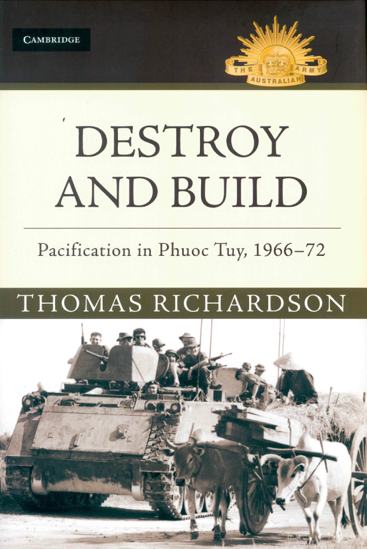Destroy and Build explores the policy and practice of ‘pacification’ conducted by the 1st Australian Task Force in the Republic of Vietnam’s Phuoc Thuy province between 1966 and 1972. Pacification was the term used for the coalition’s civilian-military strategy to defeat the communist-led National Liberation Front insurgency within the Republic’s borders. The pacification campaign included military, economic, social and political efforts. It sought to reform and remake South Vietnamese society so as to prevent it ‘falling’ to Communism.

Richardson identifies that historical research on pacification was shallow and distorted by institutional interests in the immediate Vietnam War era. Over the last decade, historical ‘cherry-picking’ has been increasingly undertaken to provide evidence for pre-determined views regarding the ‘correct’ counter-insurgency course of action in Iraq and Afghanistan. Using material from United States and Australian archives, as well as newly-translated Vietnamese histories, Richardson comprehensively documents and critically analyses the origins and logic of pacification as well as its implementation in Phuoc Thuy.
Richardson challenges the recent popular historiography of the ‘Free World’ allied forces’ fight against insurgency in Vietnam. He observes that “… those who fought in Vietnam understood the central role of the people in Maoist-inspired insurgencies”. Richardson goes on to identify that there was a “… view that poverty was the driving force of discontent in rural areas that gave pacification its transformational element – that rural Vietnamese had to be dragged into the twentieth century if [Vietnam] was to be saved from communism”. But then he deduces that “… advisers struggled to understand that [the grievances driving popular support for the Front were more complex than simply poverty], even after five years of pacification, show[ing] how deeply entrenched pre-conceptions on the nature of the conflict were in American and Australian minds”. Richardson concludes that “… although pacification did help to change Phuoc Thuy’s social, political and economic structure, it never fully succeeded in its ultimate aim of defeating the National Liberation Front”.
Richardson argues that “… the problem was the ability to recognise the nature of this social conflict in the first place”, thereby reinforcing the importance of the maxim ‘you must understand the nature of the war on which you have embarked’. He demonstrates that then, like now, ‘comprehensive’ civilian-military strategies struggle to identify clear objectives, delineate responsibility, integrate efforts and discern measures of progress.
Richardson is an adjunct lecturer in history at the University of New South Wales, Canberra, and a researcher for the Official History of Australian Operations in Iraq and Afghanistan, and Australian Peacekeeping Operations in East Timor.
Destroy and Build includes twelve black-and-white illustrations embedded in the text and six good quality maps (although the map text font could have been a little larger). Very comprehensive notes are complemented by a detailed bibliography and a good index. This is an academic-quality publication that is relevant to those with an interest in counter-insurgency, stability operations and nation-building.
Contact Marcus Fielding about this article.






